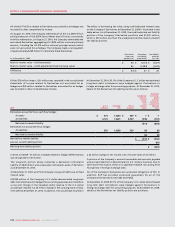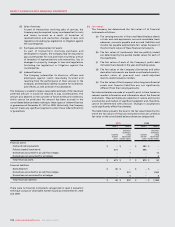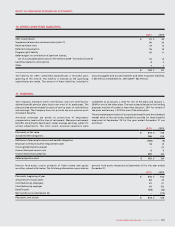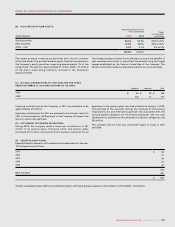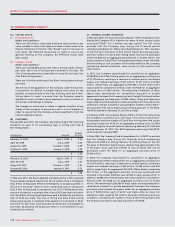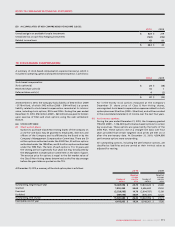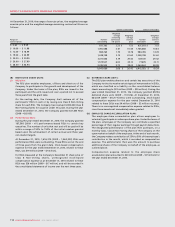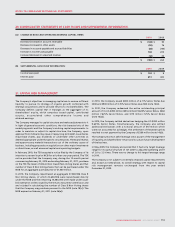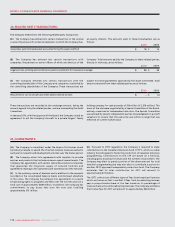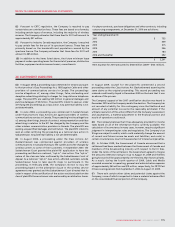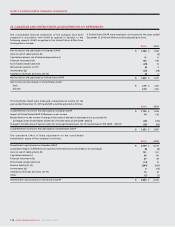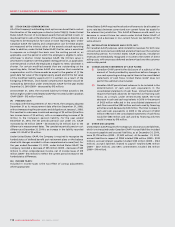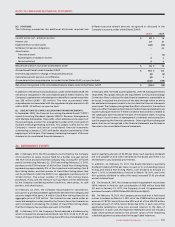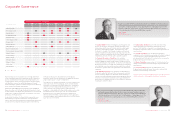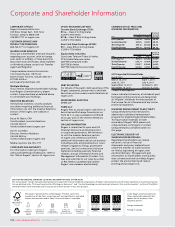Rogers 2010 Annual Report Download - page 109
Download and view the complete annual report
Please find page 109 of the 2010 Rogers annual report below. You can navigate through the pages in the report by either clicking on the pages listed below, or by using the keyword search tool below to find specific information within the annual report.
NOTES TO CONSOLIDATED FINANCIAL STATEMENTS
ROGERS COMMUNICATIONS INC. 2010 ANNUAL REPORT 113
20. CONSOLIDATED STATEMENTS OF CASH FLOWS AND SUPPLEMENTAL INFORMATION:
(A) CHANGE IN NON-CASH OPERATING WORKING CAPITAL ITEMS:
2010 2009
Decrease (increase) in accounts receivable $ (163) $ 93
Decrease (increase) in other assets (90) 76
Decrease in accounts payable and accrued liabilities (83) (155)
Increase in income taxes payable 168 205
Increase (decrease) in unearned revenue (12) 45
$ (180) $ 264
(B) SUPPLEMENTAL CASH FLOW INFORMATION:
2010 2009
Income taxes paid $ 152 $ 8
Interest paid 651 632
The Company’s objectives in managing capital are to ensure sufficient
liquidity to pursue its strategy of organic growth combined with
strategic acquisitions and to provide returns to its shareholders. The
Company defines capital that it manages as the aggregate of its
shareholders’ equity, which comprises issued capital, contributed
surplus, accumulated other comprehensive income and
retained earnings.
The Company manages its capital structure and makes adjustments to it
in light of general economic conditions, the risk characteristics of the
underlying assets and the Company’s working capital requirements. In
order to maintain or adjust its capital structure, the Company, upon
approval from its Board, may issue or repay long-term debt, issue shares,
repurchase shares, pay dividends or undertake other activities as
deemed appropriate under the specific circumstances. The Board reviews
and approves any material transactions out of the ordinary course of
business, including proposals on acquisitions or other major investments
or divestitures, as well as annual capital and operating budgets.
In February 2010, the TSX accepted a notice filed by the Company of its
intention to renew its prior NCIB for a further one-year period. The TSX
notice provides that the Company may, during the 12-month period
commencing February 22, 2010 and ending February 21, 2011, purchase
on the TSX the lesser of 43.6 million Class B Non-Voting shares and that
number of Class B Non-Voting shares that can be purchased under the
NCIB for an aggregate purchase price of $1,500 million.
In 2010, the Company repurchased an aggregate 37,080,906 Class B
Non-Voting shares, of which 22,600,906 were repurchased directly
under the NCIB and the remaining 14,480,000 were made under issuer
bid exemption orders issued by the Ontario Securities Commission and
are included in calculating the number of Class B Non-Voting shares
that the Company may purchase pursuant to the NCIB (note 18(c)). The
NCIB expired on February 21, 2011 (note 26(a)).
In 2010, the Company issued $800 million of 6.11% Senior Notes due
2040 and $900 million of 4.70% Senior Notes due 2020 (note 14(c)).
In 2010, the Company redeemed the entire outstanding principal
amount of its U.S.$490 million ($516 million) 9.625% Senior Notes, $460
million 7.625% Senior Notes, and $175 million 7.25% Senior Notes
(note 14(d)).
In 2010, the Company settled derivatives hedging the U.S.$490 million
9.625% Senior Notes. Simultaneously, the Company also settled
additional Derivatives with a notional amount of $10 million which
were not accounted for as hedges. The settlement of these Derivatives
resulted in a net payment by the Company of $269 million (note 14(d)).
The Company monitors debt leverage ratios as part of the management
of liquidity and shareholders’ return and to sustain future development
of the business.
In May 2009, the Company announced that it had set a target leverage
range for its capital structure of net debt to adjusted operating profit
of 2.0 to 2.5 times. There was no change to this target leverage range
in 2010.
The Company is not subject to externally imposed capital requirements
and, except as noted above, its overall strategy with respect to capital
risk management remains unchanged from the year ended
December31,2009.
21. CAPITAL RISK MANAGEMENT:



